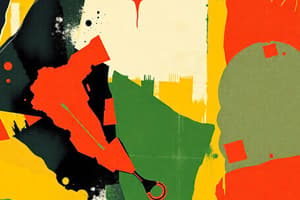Podcast
Questions and Answers
Which critical approach focuses on the author as an editor of source materials?
Which critical approach focuses on the author as an editor of source materials?
- Historical Criticism
- Tradition Criticism
- Redaction Criticism (correct)
- Canonical Criticism
What is the primary goal of Tradition Criticism?
What is the primary goal of Tradition Criticism?
- To determine the original author of the text.
- To analyze the final canonical form of the text.
- To trace the evolution of oral traditions into literary form. (correct)
- To identify the historical context of the written text only.
In historical criticism, what does 'sensus literalis historicus' refer to?
In historical criticism, what does 'sensus literalis historicus' refer to?
- The spiritual significance of the literary devices used.
- The moral interpretation of historical events.
- The text's original meaning in its historical context. (correct)
- The allegorical meaning of the text.
Which of the following best describes Canonical Criticism?
Which of the following best describes Canonical Criticism?
Paleographical analysis is used to:
Paleographical analysis is used to:
What is the purpose of Diplomatic Criticism?
What is the purpose of Diplomatic Criticism?
Historical criticism seeks to achieve which of the following?
Historical criticism seeks to achieve which of the following?
External criticism primarily aims to:
External criticism primarily aims to:
Which methodology focuses on analyzing the materials used to create a historical document to determine its authenticity?
Which methodology focuses on analyzing the materials used to create a historical document to determine its authenticity?
If a historian is trying to determine if the events described in a document align with the purported date and location of its creation, which test of authenticity are they most likely using?
If a historian is trying to determine if the events described in a document align with the purported date and location of its creation, which test of authenticity are they most likely using?
A document claims to be written in 1776 using a type of ink that was not invented until 1850. Which method would most directly reveal this discrepancy?
A document claims to be written in 1776 using a type of ink that was not invented until 1850. Which method would most directly reveal this discrepancy?
A historian discovers a seal on a document and wants to verify its authenticity and connection to the supposed author. Which of the following methods would they employ?
A historian discovers a seal on a document and wants to verify its authenticity and connection to the supposed author. Which of the following methods would they employ?
Which of the following methodologies would a historian use to decipher and interpret an ancient text to understand its writing system?
Which of the following methodologies would a historian use to decipher and interpret an ancient text to understand its writing system?
A historian is examining multiple versions of a photograph of the same scene taken at slightly different angles and times. Which method are they most likely employing?
A historian is examining multiple versions of a photograph of the same scene taken at slightly different angles and times. Which method are they most likely employing?
To understand the sources used by a biblical author, which method of historical criticism would be most appropriate?
To understand the sources used by a biblical author, which method of historical criticism would be most appropriate?
What is the primary goal of internal criticism when analyzing a historical document?
What is the primary goal of internal criticism when analyzing a historical document?
Flashcards
Historical Criticism
Historical Criticism
Examines the origins of a text to understand the circumstances of its creation.
Goal of Historical Criticism
Goal of Historical Criticism
Discover the text's original meaning in its historical context.
Another Goal of Historical Criticism
Another Goal of Historical Criticism
Reconstruct the historical situation of author and audience.
External Criticism
External Criticism
Signup and view all the flashcards
Paleographical Analysis
Paleographical Analysis
Signup and view all the flashcards
Diplomatic Criticism
Diplomatic Criticism
Signup and view all the flashcards
Form Criticism
Form Criticism
Signup and view all the flashcards
Redaction Criticism
Redaction Criticism
Signup and view all the flashcards
Source Criticism
Source Criticism
Signup and view all the flashcards
Isography
Isography
Signup and view all the flashcards
Paleography and Diplomatics
Paleography and Diplomatics
Signup and view all the flashcards
Sigillography
Sigillography
Signup and view all the flashcards
Anachronistic Styles
Anachronistic Styles
Signup and view all the flashcards
Anachronistic References to Events
Anachronistic References to Events
Signup and view all the flashcards
Study Notes
- Historical Criticism examines the origins of the earliest text.
- It appreciates the underlying circumstances upon which the text originated.
Goals of Historical Criticism
- Discovering the original meaning of the text in its primitive or historical context.
- Discovering its literal sense or sensus literalis historicus.
- Constructing the historical situation of the author and recipients of the text.
- Historical criticism includes external criticism and internal criticism.
- Historical criticism originates in during the Protestant Reformation in the 17th century
- It gained recognition in the 19th and 20th centuries
Methodologies of Historical Criticism
- Source Criticism analyzes the sources used by biblical authors.
- Form Criticism seeks to determine a unit's original form and historical context in literary tradition.
- Redaction Criticism considers the author of the text as the editor of source materials.
- Tradition Criticism attempts to trace the developmental stages of the oral tradition from its emergence to its literary presentation.
- Canonical Criticism focuses on the interpretation of the bible on the text of biblical canon.
Parts of Historical Criticism
- External criticism determines the authenticity of the source, which can be tested in two ways.
- Paleographical analysis involves deciphering and dating historical manuscripts.
- Diplomatic Criticism involves critical analysis of historical documents.
- It aids to understand how the document originated, how the information was transmitted, and the relationship between the facts and reality.
- Internal Criticism focuses on determining the historicity of the facts contained in the document.
- Proving the authenticity of the material or document is not necessary.
Test of Authenticity
- Historians utilize tests common in police and legal detection to distinguish a hoax or misrepresentation from a genuine document.
Best Guess of the Date of the Document
- Examiners assesses the document's materials for anachronisms.
- Examiners look at the inks for signs of age or anachronistic chemical composition.
Best Guess of the Possible Author of the Document
- Examiners determine if the handwriting can be compared with authenticated specimens, even if unfamiliar
Techniques Used by Historians
- Isography involves using a series of photographs that depict the same scene from different angles at different times.
- Paleography and diplomatics involves studying ancient or antiquated writings and inscriptions.
- It includes deciphering and interpreting historical writing systems and manuscripts.
- Sigillography involves studying seals, especially those used to authenticate documents.
- Anachronistic styles are detectable by specialists familiar with contemporary writing.
- Anachronistic references to events involves dating a document when the alleged writer could not have been at the designated place, uncovering fraud.
Studying That Suits You
Use AI to generate personalized quizzes and flashcards to suit your learning preferences.




